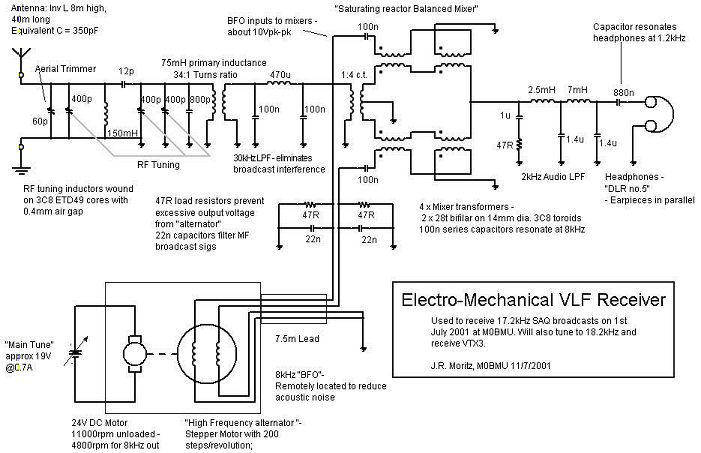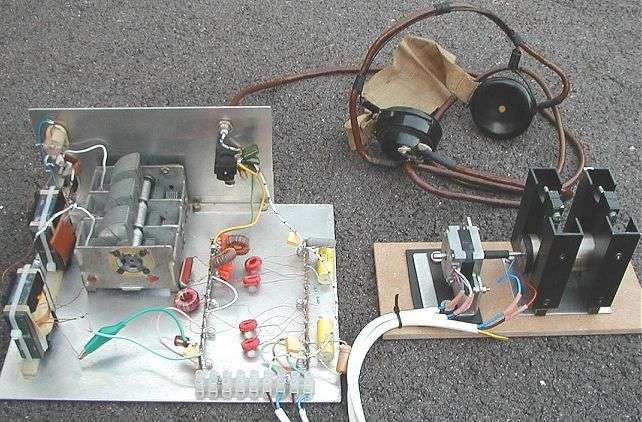An electro-mechanical RX for VLF.
Historic VLF station "SAQ" was put back on the air on 17.2kHz for a day of special transmissions on 1st July 2001. This inspired Jim Moritz, M0BMU, to construct an appropriate receiver for the event....
He writes:-
I received broadcasts at 0830 and 1230utc from SAQ yesterday, using a tuned 3m loop and RA1792 receiver with 300Hz bandwidth. Both broadcasts were RST 599 QRN. The atmospheric noise level at 17.2kHz was rather high, but did not really affect copy.
I was also able to successfully receive SAQ with a homebrew electro-mechanical receiver. As far as I know, the Alexanderson alternator at SAQ is currently the only operating radio station with an electro-mechanical transmitter that does not rely on valves or semiconductors. For some time I thought it would be fun to make a VLF receiver based on similar principles, also without any valves or semiconductors, to receive the SAQ broadcasts. At first, I thought this would involve some difficult mechanical engineering, but somewhat suprisingly I was eventually able to make such a receiver using parts from the junk box.

It is basically a direct conversion receiver. It has a 2 pole passive preselector with RF bandwidth of about 800Hz, which also impedance matches the antenna to the mixer. The mixer uses saturating ferrite cores, in a way not unlike the SAQ keying circuit. The BFO signal saturates the cores at both the positive and negative peaks of it's waveform, and so the core windings present an inductance that varies at twice the BFO frequency, in series with the signal path.
The BFO signal is produced by a small high frequency alternator. This is actually a 200 step/revolution stepper motor, salvaged from a scrap hard disk drive. When driven as a generator, it produces a reasonable sine wave - each winding produces a signal in phase quadrature with the other - with 100 cycles for each revolution. So as an HF alternator, it produces quite high frequencies when rotating at moderate speed. Driven at 4800 rpm by a DC servo motor, it generates a couple of watts at 8kHz, which effectively gives a 16kHz BFO signal, due to the frequency doubling action of the mixer. This "oscillator" is connected to the rest of the circuit with long cables, because of the mechanical noise it produces!
The resulting audio beat frequency at 1.2kHz is low pass filtered, and applied to a pair of 1944 vintage 'DLR no.5' headphones. With the two earpieces in parallel, and a series capacitor of 880nF, these are series resonant at 1.2kHz and close to 50 ohms impedance. They are suprisingly sensitive - an audio signal - 100dBm (2.2uV into 50 ohms) is just about audible in a quiet room. So although the RX has no amplification, in fact considerable loss, a 30uV signal at 17.2kHz from a signal generator can be detected at the mixer input.

The SAQ broadcasts on Sunday were received using this RX with my 8m high, 40m long inverted L antenna, which produced a comfortably audible signal in the headphones. In fact, the limit on sensitivity was the QRN, which was quite strong. Later, I re-tuned the RX to 18.2kHz, and was able to copy the VTX3 Indian navy station, although this was considerably weaker than SAQ.
I also recorded the SAQ brodcasts on tape; listening to them, RealAudio clip the main defect of the electro-mechanical receiver is poor frequency stability - the motor currently has no feedback speed contol, and so the "oscillator" frequency varies by about +/- 1% - not a problem as far as copying goes, but does sound a bit wobbly!
As far as I know, this is probably the only receiver of it's type in existence, and perhaps the only entirely electro-mechanical radio transmission and reception since the 1920s - but I would be very interested to hear if anyone knows of anything similar.
Jim Moritz M0BMU.